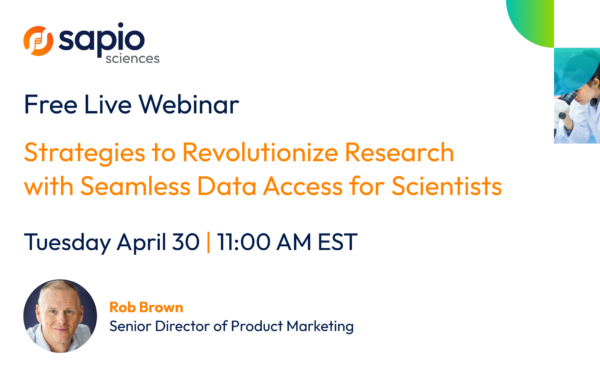Most research IT teams in the pharmaceutical and biotechnology space have encountered a common question when it comes to integrations and scientific data management: build or buy? At first thought, building an in-house, homegrown solution to integrate instruments and unify scientific data may seem like the less painful—and less costly—option. And this approach has been used successfully by many labs before.
But instrumentation in the lab continues to evolve, and so too do the requirements for data utilization. With the future of AI-powered discovery upon us and an ever-evolving array of instrumentation, a homegrown approach may lack the agility and dedicated focus needed to keep a lab ahead of the curve.
In addition, the cost and effort required to maintain a homegrown solution can be prohibitive, especially as the organization’s speed and scale increase. At the same time, sourcing and buying a data unification solution can be challenging. Many solutions make life harder, instead of easier, and fall just short of meeting a lab’s individualized demands. In order to minimize cost of ownership and maximize agility moving forward, IT teams must choose a solution that makes life easier for them and their scientists.
Read on as we compare building custom integrations to unify scientific data against implementing a unified, science-aware™ data management solution, helping you make the correct build vs buy decision for your organization.
The homegrown approach to collating instrument data
The in-house solution for instrument integration is one that many pharmaceutical and biotechnology organizations take. While saving upfront costs in the short term and mitigating the need for an outside partner are often appealing, custom development can also bring a number of challenges and inefficiencies, including:
- Manual setup: With a homegrown solution, each instrument type requires a specific parser. These parsers and connectors must be manually created and tested for each instrument, consuming significant time and creating room for error.
- Limited scalability: A homegrown solution lacks the automated scalability required to support increasing volumes of data and new and diverse instruments as they are introduced over time. This limitation is particularly crucial in the molecule lifecycle, where requirements become more robust as a molecule progresses.
- Ongoing maintenance: A homegrown solution requires manual upkeep, including regular maintenance, backups, and disaster recovery. All of this takes time from research IT teams, increasing development costs and maintenance costs and stealing critical focus from other, more strategic areas of IT.
The impact of building your own lab instrument integrations
Let’s use a hypothetical scenario to examine what happens when building in-house instrument integrations . A mid-sized pharmaceutical organization utilizes electronic lab notebooks to record and analyze experimental data, and the research IT team of six people builds manual integrations to facilitate data transfer from scientific instruments to the organization’s two ELNs.
To do this, IT first scripts and codes parsers in Python for each instrument type, then develops point-to-point connectors. Each of these parsers must be written and tested before it is implemented, taking about 80 hours of development and quality assurance per parser. An additional 160 hours of the team’s time are spent developing and quality assuring connectors to each of the lab’s two ELNs.
But the IT team’s work isn’t complete. A new version of the ELN software is released, and the research IT team must then update and retest each of the instrument connections to ensure they work properly. To make matters worse, the organization has 15 labs in total. When one of the labs purchases a new mass spectrometer, which must be connected to the ELN, the IT team must develop and test a new connector, which takes several days. This process is repeated each time one or more of the labs purchases a new instrument. Instrumentation is always evolving, and the research IT team spends a disproportionately high amount of their time on coding and maintenance.
The science-aware™ approach to instrument integration
To mitigate manual effort and maintain total continuity across their lab informatics landscape, research IT teams require an instrument integration solution that can support the mounting volume and complexity of their scientific data from the very start, and do so in a way that is fully integrated with their ELN or LIMS.
Here are some of the benefits research IT teams can experience by implementing a proper scientific data platform:
- Automated data handling: A solution that is purpose-built for the volume and scale of scientific data—and is part of a single platform along with the organization’s LIMS and ELN—eliminates the need to develop custom connections for data transfer. Instead, data is automatically updated and synchronized across the lab’s LIMS, ELN, and data solution.
- Flexibility and scalability: As the volume of data grows and new instruments are added over time, new parsers can be developed and implemented rapidly by an experienced partner. Once the parsers are added, this data flows freely into the lab’s LIMS and ELN.
- Simplified maintenance: With a proper platform and partner, regular maintenance, backups, and disaster recovery are handled by a skilled professional services organization, giving internal research IT teams time back to spend on more valuable aspects of IT.
Let’s see how our hypothetical research IT team’s workflow might transform when they choose to implement a science-aware™ scientific data platform.
Out of the box, the solution already includes parsers and connectors for many of the lab’s most popular instruments. For the others, a skilled professional services team quickly develops new parsers, allowing the research IT team to spend their time on project support, infrastructure management, and other more pressing tasks.
The data solution comes as an integrated part of a unified platform, which includes the lab’s LIMS and ELN. This means data flows freely and automatically from mass spectrometers and all the lab’s other key instruments to these tools, ensuring that scientists always have access to the latest data. Ongoing maintenance, backups, and disaster recovery are handled by the solution provider’s team, further freeing research IT’s time for more critical projects.
Updates occur at the platform level, mitigating costly data interruption and the subsequent need for additional IT involvement. The organization achieves total data continuity across its lab informatics landscape while simultaneously ensuring the agility needed to adapt to future requirements.
Demonstrating the value of a science-aware™ solution
By choosing to implement a robust science-aware™ data solution, as opposed to developing custom parsers and connections, the research IT team can spend more time on urgent or strategic IT tasks and less time on development and upkeep.
Before, with one developer per instrument and two ELNs, it would take up to 13 working weeks to integrate a new instrument into the system, assuming the developer spent 75% of their time on coding and reserved the rest for troubleshooting and other critical activities as they arose. Now, this time is eliminated altogether. Instead of reserving just 25% of their time to address more pressing tasks, the developer can dedicate all their time to project support, cybersecurity, and other priorities. With six research IT team members in total, the organization gains back thousands of hours each year to focus on adopting innovative new technologies across their labs, protecting their IT infrastructure, unlocking new project efficiencies, and much more.
In addition, scientists can get up and running with a new instrument rapidly, and accelerate projects and experiments that rely on that instrument. The organization’s productivity increases substantially, as scientists and IT teams can both work more efficiently and effectively.
Simplifying system and instrument data integration with Sapio Jarvis
While significant custom development is assumed a necessary evil for many scientific organizations that are attempting to solve the instrument integration problem, there is a powerful alternative that not only addresses the integration challenge but also transforms data utilization throughout the scientific workflow.
As a science-aware™ solution for scientific data integration, Sapio Jarvis powerfully harmonizes instrument and system data in a single platform. With Sapio’s dynamic platform and expert support, research IT teams can get up and running quickly, maintain their solution more effectively, and easily add new integrations as their organization grows. But the real power of Sapio Jarvis comes from the fact that it is part of a single platform for lab informatics—one that harmonizes research data, LIMS, and ELN in one, unified whole.
If you’re interested in learning more about the assumptions behind this blog post or would like to see a demo of Jarvis, contact Sapio today.





